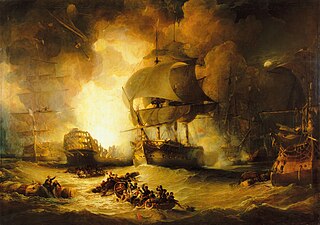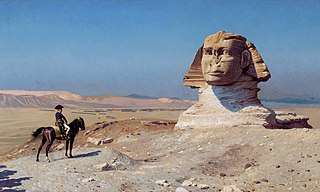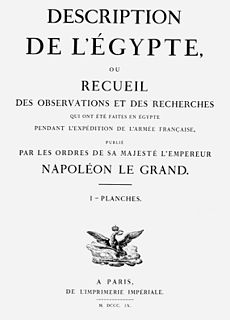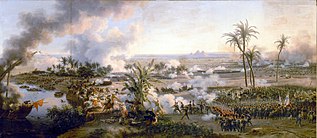 W
WThe French campaign in Egypt and Syria (1798–1801) was Napoleon Bonaparte's campaign in the Ottoman territories of Egypt and Syria, proclaimed to defend French trade interests, seek further direct alliances with Tipu Sultan, weaken Britain's access to India, and to establish scientific enterprise in the region. It was the primary purpose of the Mediterranean campaign of 1798, a series of naval engagements that included the capture of Malta. The campaign ended in defeat for Napoleon, and the withdrawal of French troops from the region.
 W
WThe Battle of Abukir was a battle in which Napoleon Bonaparte defeated Seid Mustafa Pasha's Ottoman army on July 25, 1799, during the French campaign in Egypt. It is considered the first pitched battle with this name, as there already was a naval battle on August 1, 1798. No sooner had the French forces returned from a campaign to Syria, than the Ottoman forces were transported to Egypt by Sidney Smith's British fleet to put an end to French rule in Egypt.
 W
WThe Battle of Abukir of 8 March 1801 was the second pitched battle of the French campaign in Egypt and Syria to be fought at Abu Qir on the Mediterranean coast, near the Nile Delta.
 W
WThe Siege of Acre of 1799 was an unsuccessful French siege of the Ottoman city of Acre and was the turning point of Napoleon's invasion of Egypt and Syria, along with the Battle of the Nile. It was Napoleon's first decisive defeat in his career as three years previously he had been tactically defeated at the Second Battle of Bassano. As a result of the failed siege, Napoleon Bonaparte retreated two months later and withdrew to Egypt.
 W
WThe Armée d'Orient was the French military force gathered by the French Directory to send on the expedition to Egypt in 1798. The expedition had the intention of barring Great Britain's route to its colonies in India and was put under the command of Napoleon Bonaparte.
 W
WThe Attarine Mosque also known as the Mosque of St. Athanasius or the Mosque of a Thousand Columns was a Catholic Church-turned mosque that is situated in the Attarine District in Alexandria, Egypt. The former church was built in 370 AD and is dedicated to St. Athanasius of Alexandria. When Islam came to Egypt, the church was converted to a small mosque.
 W
WThe Battle of Alexandria, or Battle of Canope, was fought on 21 March 1801 between the army of Napoleon's French First Republic under General Jacques-François Menou and the British expeditionary corps under Sir Ralph Abercromby. The battle took place near the ruins of Nicopolis, on the narrow spit of land between the sea and Lake Abukir, along which the British troops had advanced towards Alexandria after the actions of Abukir on 8 March and Mandora on 13 March. The fighting was parts of the French campaign in Egypt and Syria against the Ottoman Empire, which began in 1798.
 W
WThe Battle of Mount Tabor, also known as the Skirmish of Mount Tabor, was an engagement between French forces under Jean Baptiste Kléber, aided in the second part of the battle by reinforcements lead by General Bonaparte, which defeated an Ottoman force led by Abdullah Pasha al-Azm of Damascus on 16 April 1799. Napoleon Bonaparte was besieging Acre, the Ottoman governor of Damascus sent an army to relieve the siege, and Kléber sought to intercept it.
 W
WThe Battle of the Nile was a major naval battle fought between the British Royal Navy and the Navy of the French Republic at Aboukir Bay on the Mediterranean coast off the Nile Delta of Egypt from the 1st to the 3rd of August 1798. The battle was the climax of a naval campaign that had raged across the Mediterranean during the previous three months, as a large French convoy sailed from Toulon to Alexandria carrying an expeditionary force under General Napoleon Bonaparte. The British fleet was led in the battle by Rear-Admiral Sir Horatio Nelson; they decisively defeated the French under Vice-Admiral François-Paul Brueys d'Aigalliers.
 W
WThe Siege of Cairo also known as the Cairo Campaign was a siege that took place during the French Revolutionary Wars, between French and British with Ottoman forces and was the penultimate action of the Egyptian Campaign. British commander John Hely-Hutchinson advanced to Cairo, where he arrived after a few skirmishes in mid June. Joined by a sizeable Ottoman force Hutchinson invested Cairo and on 27 June the surrounded 13,000-strong French garrison under General Augustin Daniel Belliard, out-manned and out-gunned then surrendered. The remaining French troops in Egypt under Jacques-François Menou disheartened by this failure, retired to Alexandria.
 W
WThe Convention of El Arish was signed on 24 January 1800 by representatives from France and the Ottoman Empire in the presence of a British representative. It was intended to bring to an end the French campaign in Egypt and Syria, with the repatriation of French troops to France and the return of all territory to the Ottomans.
 W
WThe Description de l'Égypte was a series of publications, appearing first in 1809 and continuing until the final volume appeared in 1829, which aimed to comprehensively catalog all known aspects of ancient and modern Egypt as well as its natural history. It is the collaborative work of about 160 civilian scholars and scientists, known popularly as the savants, who accompanied Bonaparte's expedition to Egypt in 1798 to 1801 as part of the French Revolutionary Wars, as well as about 2000 artists and technicians, including 400 engravers, who would later compile it into a full work.
 W
WThe Egypt Medal is a campaign medal that was awarded by the Governor-General of India to members of the expeditionary force that travelled from India to take part in the 1801 Egyptian campaign, a part of the French Revolutionary Wars.
 W
WThe Battle of Heliopolis was a French victory by the armée d'Orient under General Kléber over the Ottoman army at Heliopolis on 20 March 1800.
 W
WThe Institut d'Égypte or Egyptian Scientific Institute is a learned society in Cairo specializing in Egyptology. It was established in 1798 by Napoleon Bonaparte to carry out research during his Egyptian campaign and is the oldest scientific institute in Egypt. The building in which it was housed was burnt down, with the loss of many documents, during the Arab Spring unrest of 2011. It reopened in December 2012.
 W
WThe Siege of Jaffa was a military engagement between the French army under Napoleon Bonaparte and Ottoman forces under Ahmed al-Jazzar. On the 3 of March, 1799, the French laid siege to the city of Jaffa, which was under Ottoman control. It was fought from 3 to 7 March 1799. On the 7 March, French forces managed to capture the city.
 W
WThe Battle of Mandora was a minor battle fought on 13 March 1801 between French forces under François Lanusse and the British expeditionary corps under Ralph Abercromby, during the French campaign in Egypt and Syria.
 W
WThe Battle of the Pyramids, also known as the Battle of Embabeh, was a major engagement fought on 21 July 1798 during the French Invasion of Egypt. The French army, under Napoleon Bonaparte, scored a decisive victory against the forces of the local Mamluk rulers, wiping out almost the entire Ottoman army located in Egypt. It was the battle where Napoleon employed the divisional square tactic to great effect. Actually a rectangle, the deployment of the French brigades into these massive formations repeatedly threw back multiple cavalry charges by the Mamluks.
 W
WThe Revolt of Cairo was a revolt that occurred on 21-22 October 1798 by the citizens of Cairo against the French occupation of Egypt led by Napoleon Bonaparte.
 W
WThe Rosetta Stone is a granodiorite stele inscribed with three versions of a decree issued in Memphis, Egypt in 196 BC during the Ptolemaic dynasty on behalf of King Ptolemy V Epiphanes. The top and middle texts are in Ancient Egyptian using hieroglyphic and Demotic scripts respectively, while the bottom is in Ancient Greek. The decree has only minor differences between the three versions, making the Rosetta Stone key to deciphering Egyptian hieroglyphs.
 W
WThe Battle of Shubra Khit, also known as the Battle of Chobrakit, was the first major engagement of Napoleon's campaign in Egypt that took place on 13 July, 1798. On their march to Cairo, the French army encountered an Ottoman army consisting of Mamluk cavalry and drafted Fellahins under Murad Bey. Napoleon lined his forces up into infantry squares, a tactic which helped repel the Mamluk cavalry, largely due to their inability to penetrate them without suffering severe casualties. A naval battle also occurred, with an Ottoman flotilla being repelled by a French flotilla.
 W
WThe Siege of Alexandria was fought between 17 August and 2 September 1801, during the French Revolutionary Wars, between French and British forces and was the last action of the Egyptian Campaign. The French had occupied Alexandria, a major fortified harbour city on the Nile Delta in northern Egypt, since 2 July 1798, and the garrison there surrendered on 2 September 1801.
 W
WThe Siege of Fort Julien was a military engagement that took place during the French Revolutionary Wars as part of the French campaign in Egypt and Syria from 8 to 19 April 1801. The action was between a British and Ottoman force numbering 2,000 men and a besieged French force of 300 men.